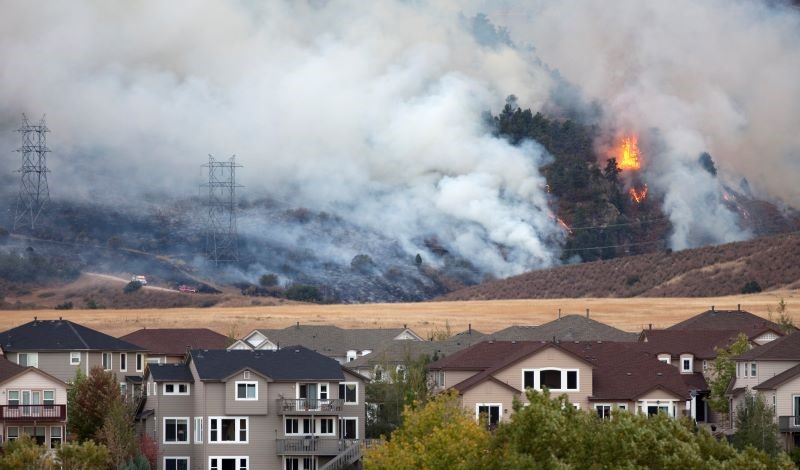
Scholars identify wildfire resilience solutions for the power sectors in California and Australia.
Despite being separated by an ocean, California and Australia face a common enemy: wildfires. As climate change raises temperatures and aggravates the frequency and severity of droughts in many parts of the world, legal experts from both sides of the Pacific argue that wildfires threaten the electricity grid in both countries.
In a recent article, Rosemary Lyster, at the University of Sydney Law School, Daniel A. Farber, at the University of California, Berkeley School of Law, and Rory McFadden, a former research assistant at the University of Queensland, argue that governments and utility companies need to adopt better regulatory, technological, and land-use solutions to protect their grids.
Lyster, Farber, and McFadden note that heat waves and drought are associated with fire weather because together they produce low soil moisture and humidity, high temperatures and wind speeds, and an increase in vapor pressure deficit.
In many places—including Australia and California—these compounding effects have led to record breaking wildfires in recent years. In addition to destroying homes, these fires also damage and destroy transmission and distribution lines. The extreme heat from a wildfire can also increase conduction, leading power lines to arc to the ground and spark further fires.
Lyster, Farber, and McFadden identify the dual risk this poses to the power sector, as the grid can both cause wildfires and be damaged by them. This dual risk underscores the importance of resilience, which aims to minimize electricity infrastructure’s exposure to vulnerabilities, threats, and hazards.
In Australia, reliability—not resilience—is a National Electricity Objective under the law that grants national energy regulatory bodies its authority. The operator of the country’s grids, the Australian Energy Market Operator, drafted an Integrated System Plan in 2020 that included an extensive list of resilience criteria for utilities. Lyster, Farber, and McFadden note that, due to the highly privatized nature of the power sector, no legal requirement to adopt any of these measures exists.
In California, Lyster, Farber, and McFadden contend that the California Public Utility Commission (CPUC) emphasizes adaptability over resilience as a regulatory objective. Following a 2020 order, the CPUC requires utilities to create cross-department climate change teams and mandates that a senior executive supervise them.
In addition, the CPUC instructs utilities to obtain climate risk information when working with suppliers under long-term purchase agreements—deals that must be separately approved by the CPUC. Lyster, Farber, and McFadden conclude that California illustrates how regulatory bodies can highlight resilience objectives and ensure utilities internalize climate risks.
Lyster, Farber, and McFadden argue that another key part of grid resilience involves transitioning to renewable energy production. They delve into the various technological adaptations that Australia and California have each implemented, including distributed energy resources (DER) such as rooftop solar panels and behind-the-meter batteries, which store locally generated power for later use.
This technology enables people to be “prosumers”—both consumers and producers of electricity—thereby easing or eliminating the burden on existing power facilities. Due to the long connections between power sources and consumers, rural areas are especially susceptible to wildfires interrupting electricity access, note Lyster, Farber, and McFadden. Implementing DER technology creates the possibility of stand-alone power systems—or microgrids—that can provide more reliable energy to these communities.
Australia leads the world in DER implementation—over 25 percent of Australian homes have solar panels. But California is moving forward to promote solar energy as well. The state has mandated that all new homes have solar panels installed. In April 2022, the CPUC updated its DER Action Plan to provide a roadmap for a statewide DER framework. And multiple California utility companies have committed to battery storage projects totaling over 1.3 gigawatts.
Land-use planning constitutes the final area that Lyster, Farber, and McFadden identify as capable of increasing grid resilience. Despite Australia’s fragmentation into states and territories, Lyster, Farber, and McFadden assert that the country has made more progress than California in incorporating wildfire risks into land-use planning. They attribute this phenomenon to the availability of robust planning resources, such as a disaster resilience handbook that is geared towards emergency management professionals, land use planners, and developers.
Lyster, Farber, and McFadden also focus on Victoria and New South Wales as pointing the way for California due to its advanced regulatory frameworks. Victoria requires major electricity companies to fulfill bushfire mitigation requirements and to submit annual plans.
Lyster, Farber, and McFadden highlight the Victorian government’s financial incentive scheme that benefits energy distributors based on the number of decreasing grid ignitions. New South Wales only gives development consent in bushfire-prone land if the relevant local authority determines that plans comply with state bushfire planning assessments.
In California, Lyster, Farber, and McFadden identify land-use management as primarily a local responsibility, with some statewide benchmarks present for wildland-urban interfaces. They emphasize that a large gap exists in new housing laws for fire prone areas because local governments are reluctant to inhibit building given statewide housing shortages. Overall, they assert that California enforces weaker local land-use planning and should follow Australia’s lead.
California and Australia must embrace grid resilience, according to Lyster, Farber, and McFadden. After exploring the relative strengths of existing regulatory objectives, technology implementations, and land-use planning, they advocate continual policy experimentation and investigation. They conclude that, by studying each other’s pitfalls and adopting one another’s successes, California and Australia can achieve grid resilience, provide guidance to other jurisdictions, and evolve to a warming world.



